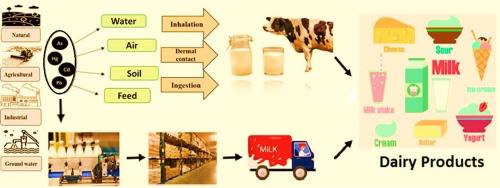Quantification of toxic metals contamination and health risk assessment in processed and raw dairy products in Abbottabad city
IF 5.4
Q2 ENGINEERING, ENVIRONMENTAL
引用次数: 0
Abstract
Toxic metal contamination (such as Cd, Cr and Pb) in processed and raw dairy products is an important environmental and public health concern. The accumulation of these metals in dairy products causes health threats to consumers. Various anthropogenic and natural activities discharge metals into the soil, where they are consumed by plants and become a part of the food chain. In addition, there is a considerable risk of metal contamination in dairy products during various business processes. The present study was carried out to determine the quantities of toxic metals found in dairy product samples. These dairy products have been classified into two groups: raw dairy products, which were self-extracted from cows and buffaloes employing adequate hygiene, and processed dairy products, which were bought from the Abbottabad market. These samples were generated using a double acid digestion approach, and toxic metals were quantified using atomic absorption spectrophotometry (AAS). For health risk assessment, the Health Risk Index (HRI), Target Hazard Quotient (THQ), and the Target Cancer Risk (TCR) indices were used. The relative levels of toxic metals in processed dairy product samples were as follows: Cd levels were highest in cheese (0.106±0.006 mg/kg), followed by butter and desi ghee (0.089±0.066 and 0.074±0.043 mg/kg, respectively). Cr concentrations were maximum in flavored milk (0.471± 0.290 mg/kg) and desi ghee (0.371± 0.01 mg/kg). Pb levels found in cheese were higher (1.753±0.194 mg/kg), then desi ghee and butter (1.025±0.01 and 0.652±0.397 mg/kg, respectively). Toxic metals in raw dairy products were measured in cow samples in the order of Cr ≥ Pb ≥ Cd. In a similar manner for buffalo samples, toxic metals followed the same trend as in cow samples. Though the concentrations of targeted metals in both raw and processed dairy product samples exceeded the threshold levels, the estimated levels of THQ and TCR were within the permissible range. However, our findings suggest that these metals in dairy products should be assessed on a continuous basis, as anthropogenic activities are contributing substantially to metal contamination.

阿伯塔巴德市加工乳制品和未加工乳制品中有毒金属污染定量及健康风险评估
加工和未加工乳制品中的有毒金属污染(如镉、铬和铅)是一个重要的环境和公共健康问题。这些金属在乳制品中的积累会对消费者的健康造成威胁。各种人为和自然活动将金属排放到土壤中,被植物消耗,成为食物链的一部分。此外,在乳制品的各种加工过程中,金属污染的风险也相当大。本研究旨在确定乳制品样本中有毒金属的含量。这些乳制品被分为两类:原料乳制品和加工乳制品,前者是从奶牛和水牛身上通过适当的卫生措施自行提取的,后者则是从阿伯塔巴德市场上购买的。这些样品采用双酸消化法提取,并使用原子吸收分光光度法(AAS)对有毒金属进行定量。在进行健康风险评估时,使用了健康风险指数(HRI)、目标危害商数(THQ)和目标癌症风险(TCR)指数。加工乳制品样本中有毒金属的相对含量如下:奶酪中的镉含量最高(0.106±0.006 毫克/千克),其次是黄油和酥油(分别为 0.089±0.066 毫克/千克和 0.074±0.043 毫克/千克)。铬的浓度在风味奶(0.471± 0.290 毫克/千克)和 desi 起酥油(0.371± 0.01 毫克/千克)中最高。奶酪中的铅含量较高(1.753±0.194 毫克/千克),然后是德西酥油和黄油(分别为 1.025±0.01 和 0.652±0.397 毫克/千克)。在奶牛样本中,有毒金属的含量依次为 Cr ≥ Pb ≥ Cd。同样,水牛样品中的有毒金属含量也与奶牛样品中的趋势相同。虽然生乳制品和加工乳制品样本中的目标金属浓度都超过了阈值水平,但 THQ 和 TCR 的估计水平都在允许范围内。不过,我们的研究结果表明,由于人为活动是造成金属污染的主要原因,因此应持续评估乳制品中的这些金属。
本文章由计算机程序翻译,如有差异,请以英文原文为准。
求助全文
约1分钟内获得全文
求助全文
来源期刊

Journal of hazardous materials advances
Environmental Engineering
CiteScore
4.80
自引率
0.00%
发文量
0
审稿时长
50 days
 求助内容:
求助内容: 应助结果提醒方式:
应助结果提醒方式:


